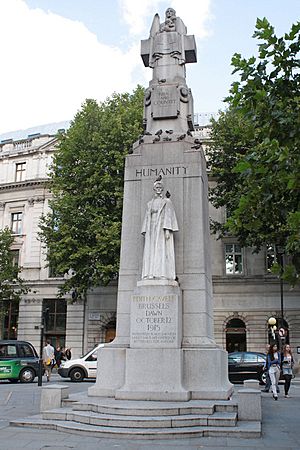Edith Cavell Memorial facts for kids

The main sculpture and south face of the memorial in 2011
|
|
| Coordinates | 51°30′34″N 0°07′38″W / 51.509324°N 0.127183°W |
|---|---|
| Location | St. Martin's Place, London, WC2 |
| Designer | Sir George Frampton |
| Type | Sculpture |
| Material | Carrara marble and grey Cornish granite |
| Height | 40 feet (12 m) |
| Opening date | 17 March 1920 |
| Dedicated to | Edith Cavell |
The Edith Cavell Memorial is a special monument in London, United Kingdom. It honors Edith Cavell, a brave British nurse. The memorial stands in St Martin's Place, close to famous spots like Trafalgar Square and the National Gallery. It's also near where the British Red Cross first had its main office.
Contents
Who Was Edith Cavell?
Edith Cavell was a British nurse from Norfolk, England. When World War I started in 1914, she was working as a head nurse in Brussels, Belgium. She cared for injured soldiers from all sides, showing no favoritism.
A Nurse's Courageous Act
Edith also secretly helped about 200 Allied soldiers escape from German-controlled Belgium. In August 1915, she was arrested for this. She was found guilty of helping the enemy and, sadly, was executed by a German firing squad on October 12, 1915.
Her Legacy and Memorial
Edith Cavell's story became a powerful example of German cruelty in British wartime messages. After the war, her body was brought back to Britain in May 1919. She received a special state funeral at Westminster Abbey before being buried at Norwich Cathedral.
Even though Edith's sister thought no monuments were needed, people wanted to remember her. A group led by Harry Levy-Lawson, 1st Viscount Burnham helped raise money for a public memorial. Sir George Frampton, a famous sculptor, agreed to design it for free.
What Does the Memorial Look Like?

The Edith Cavell Memorial is designed in a modern style. It features a 10-foot (3.0 m) tall statue of Edith Cavell herself. She is shown in her nurse's uniform, carved from white marble. This statue stands on a gray granite base.
The Tall Granite Pylon
Behind Edith's statue is a much larger gray granite pillar, called a pylon. This pylon is 40 feet (12 m) tall and weighs a huge 175 tons. The very top of the pylon is carved into a cross. Below the cross, there's a sculpture of a mother and child. Some people think this represents the Virgin Mary and baby Jesus. The entire memorial stands on three steps.
Important Words on the Memorial
On the base below Edith's statue, you can read these words: "Edith Cavell // Brussels // Dawn // October 12th 1915 // Patriotism is not enough // I must have no hatred or // bitterness for anyone." The last three lines are famous words Edith said the night before she died. They were added to the memorial in 1924.
The granite pylon also has other words carved into its sides. The front, behind Edith's statue, says "Humanity." Higher up, below the mother and child sculpture, it says "For King and Country." Other sides of the pylon have the words "Devotion," "Fortitude," and "Sacrifice." On the back, there's a carving of a lion crushing a snake, and the words "Faithful until death."
Unveiling and Recognition
The memorial was officially revealed to the public by Queen Alexandra on March 17, 1920. It was recognized as an important historical building in 1970. In 2014, its status was upgraded, showing how important it is to British history.
Images for kids


